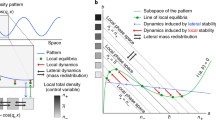Abstract
Reaction-diffusion systems show a fast and rather complex response on patterns produced by external space- and/or time-dependent perturbations. For example, one-component autocatalytic reactions rapidly find the loci where the given space-dependent reaction rates have relatively high values by following a kind of Darwinian strategy (combining self-reproduction and diffusion). It is shown that a simulation of this strategy in combination with annealing (decreasing the diffusion rates in time) may be used as an alternative to thermodynamic annealing strategies. Many-component reactions, such as the light-sensitive Belousov-Zhabotinsky reaction, show a more complex response to patterns impressed by illumination, for example. The response behavior and possible applications to dynamic information processing are discussed.
Similar content being viewed by others
References
A. Turing,Phil. Trans. Roy. Soc. B 237:37–72 (1952).
K. G. Kirby and M. Conrad,Bull. Math. Biol. 46:765–783 (1984); E. Libermanet al., Brain Res.338:33–44 (1985).
M. Conrad,Commun. ACM 28:464–480 (1985).
K. G. Kirby and M. Conrad, Physica16D (1986), to appear.
M. Conrad and F. T. Hong, inProceedings International Symposium Future Electronic Devices (1985), pp. 89–94.
L. Kuhnert,Nature 319:393–394 (1986);Naturwissenschaften 73:96–97 (1986).
W. Ebeling and A. Engel,Syst. Anal. Model. Simul. 3:377–385 (1986).
S. Kirkpatrick, C. D. Gelatt, and M. P. Vecchi,Science 220:671–680 (1983).
S. Kirkpatrick,J. Stat. Phys. 34:975–986 (1984).
J. S. Nicolis,Kybernetes 14:167–172 (1985).
T. Hogg and B. A. Huberman,J. Stat. Phys. 41:115–123 (1985).
W. Ebeling, A. Engel, B. Esser, and R. Feistel,J Stat. Phys. 37:369–384 (1985).
W. Ebeling and R. Feistel,Ann. Physik 34:81–90 (1977).
R. Landauer,Helv. Phys. Acta 56:847–856 (1983).
W. Ebeling, L. Kuhnert, B. Roeder, and L. Schimansky-Geier,Math. Biol. Newsl. 1:6 (1986).
A. S. Mikhailovet al., Phys. Lett. 96A:453–457 (1983).
L. Schimansky-Geieret al., Ann. Phys. (Leipzig) 40:10–24, 277–286 (1983).
R. J. Field and R. M. Noyes,J. Chem. Phys. 60:1877–1883.
L. Kuhnert, L. Pohlmann, H. J. Krug, and G. Wessler, inProceedings Conference Self-Organization by Nonlinear Irreversible Processes Kuhlungsborn 1985 (Springer-Verlag, Berlin, 1986).
G. Nicolis and I. Prigogine,Self-Organization in Non-Equilibrium Systems (Wiley, New York, 1977).
Author information
Authors and Affiliations
Rights and permissions
About this article
Cite this article
Ebeling, W. Pattern dynamics and optimization by reaction diffusion systems. J Stat Phys 45, 891–903 (1986). https://doi.org/10.1007/BF01020580
Received:
Issue Date:
DOI: https://doi.org/10.1007/BF01020580




